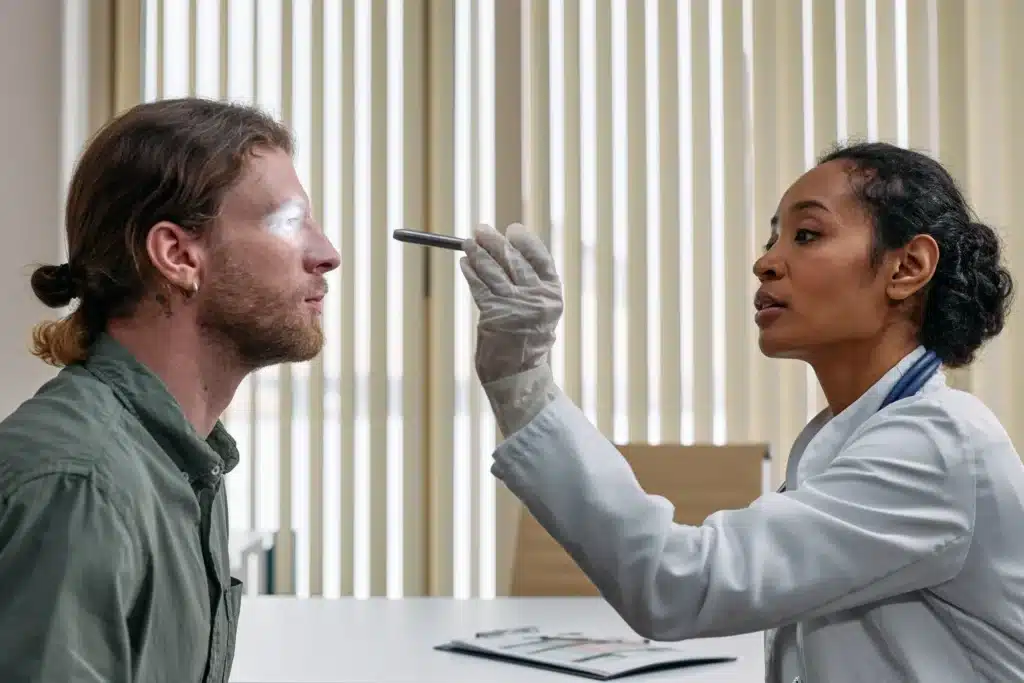Laser-assisted in situ keratomileuses, also known as LASIK, is one of the most common laser eye surgery procedures in the world and is performed around 700,000 times each year. It was invented by a Russian ophthalmologist in 1974 and eventually approved by the FDA in 1999.
LASIK eye surgery is designed to correct refractive errors of the eye — including hyperopia (farsightedness), myopia (nearsightedness), and astigmatism. Nearly 10 million people have received the surgery since 2000 as it continues to be a popular option for eye care patients.
What Are the Pros & Cons of LASIK Eye Surgery?
During the LASIK eye surgery procedure, your preferred eye surgeon will use an excimer laser to reshape the cornea by removing a thin layer of corneal tissue. This allows incoming light rays to bend and focus on the retina properly, which is essential to clear and healthy vision.
Like any other surgery, it comes with a variety of pros and cons to consider before determining if LASIK is right for you. There are life-changing benefits, but there are also risks, side effects, and complications involved. Don’t worry, we’re going to break down everything you need to know.
Breaking Down the Pros of LASIK Surgery
The LASIK procedure wouldn’t be as popular and widely accepted as it is today if it didn’t come with some extremely important benefits. For a majority of LASIK patients, these benefits are going to be life-changing and will allow them to lead a quality, happy, and healthy lifestyle.
If you’re considering LASIK to correct a refractive error and improve your vision, be prepared to be amazed by all the amazing benefits it offers. Let’s take a look:
The LASIK procedure is quick, safe, and effective.
The LASIK procedure was approved by the FDA in 1999 and has been performed on millions of patients since then. Some studies suggest nearly 96-98% of LASIK patients eventually achieve perfect 20/20 vision. It’s an outpatient procedure that only takes 20-30 minutes to complete.
LASIK patients notice improved vision in just a few hours.
For the most part, LASIK patients can expect to notice an improvement in their vision a few hours post-surgery. By the next day, your vision will likely be better than it has been in a long time. Results come quick and it’s one of the reasons so many people consider LASIK surgery.
Most LASIK patients don’t need glasses or contact lenses.
Speaking of reasons why so many people consider LASIK, who wouldn’t want to ditch those glasses and contact lenses? Most LASIK patients will achieve improved vision without needing a prescription. Of course, older patients might still need reading glasses if they have presbyopia.
The healing and recovery period is rather short with LASIK.
Most LASIK patients will fully recover within 3-6 months of the surgery. During that time, your eyes will heal and you’ll have several follow-ups with your eye surgeon to monitor the recovery process. It might take months to fully recover, but you’ll notice a difference almost immediately.
LASIK patients experience an improved quality of life.
When most patients decide to follow through with LASIK surgery, they had already been living with blurred vision for several years. When their vision finally improves post-surgery, they’re overcome with an overwhelming amount of gratitude, appreciation, happiness, and relief.
Breaking Down the Cons of LASIK Surgery
Despite all the amazing benefits of LASIK eye surgery, by no means is it a perfect procedure and it’s not going to be right for everyone. It comes with a variety of cons that each patient must consider before making a final decision. Don’t worry, your eye doctor will be there to help you.
While you should speak with your ophthalmologist to determine whether it’s right for you or not, let’s take a brief look at some of the most common downfalls to LASIK surgery:
Not everyone is eligible for LASIK eye surgery.
Most patients over the age of 50 are likely to be turned away from LASIK surgery due to the presence of presbyopia. Other patients that aren’t eligible are those with a fluctuating prescription, those with dry eyes, those that aren’t in good health, and those with thin corneas.
The corneal flap created with LASIK can be injured.
Since the corneal flaps — which provide protection to the operated area — aren’t secured to the eye, any form of eye trauma or making contact with your eye could dislodge the flap. That’s why you shouldn’t rub your eye and should schedule an appointment if anything doesn’t seem right.
Some LASIK patients experience myopia regression.
Myopia regression is when your vision slowly returns to its original refraction, which generally occurs years after the LASIK procedure was completed. The good news is it’s a rare occurrence, but one you should definitely be aware of. It could require another LASIK procedure.
There are several potential side effects and risks with LASIK.
All surgeries come with a number of side effects and risks that play a role in the decision to go through with it — or not. For LASIK, many people experience dry eyes for several weeks after the procedure and other patients experience nighttime glares and halos surrounding lights.
LASIK is a permanent procedure and there’s no going back.
Unlike some of the other surgeries to correct a refractive error, LASIK is a permanent procedure and there’s no going back once you have it. The thin layer of the cornea that’s removed is gone for good. While that’s not necessarily a bad thing, it’s something you shouldn’t overlook.
Contact Us to Learn More About the LASIK Procedure
The LASIK procedure continues to be a preferred option when correcting refractive errors in the eye and improving eyesight. With that said, it’s not your only option and not everyone is eligible for it. Don’t worry, our team of trusted specialists can help you find the safest and most effective solution.
At Milwaukee Eye Care Brookfield, we take pride in providing each patient with quality eye care services. To schedule an eye exam and learn more about the LASIK procedure, contact an Eye Doctor Milwaukee today!





